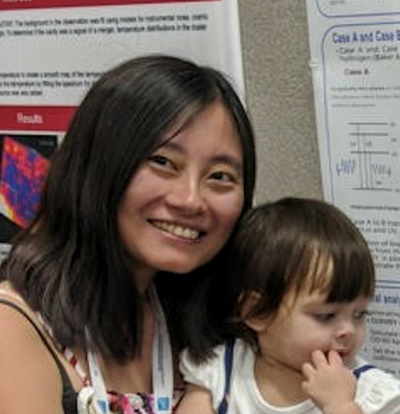 Yuanyuan Su joined the University of Kentucky as an assistant professor of astronomy in 2019 after being a postdoc at the Harvard-Smithsonian Center for Astrophysics.
Yuanyuan Su joined the University of Kentucky as an assistant professor of astronomy in 2019 after being a postdoc at the Harvard-Smithsonian Center for Astrophysics.
She is originally from Sichuan, China, the hometown of giant pandas. Su received her Ph.D. from the University of Alabama and went on to a postdoc in California before moving to Harvard.
Her primary research interest lies in clusters of galaxies. They are the largest gravitationally bound objects in the universe, containing thousands of galaxies that are held together by dark matter. The space between galaxies is filled with a very diffuse gas, the so-called “intracluster medium."
This gas is so hot that it radiates in X-rays but is undetectable at visual wavelengths. Su and her colleagues use space-based telescopes to observe galaxy clusters since the Earth's atmosphere absorbs X-rays.
Su recently published an Astrophysics Journal (ApJ) study using HISAKI, a small extreme ultraviolet space telescope operated by the Japan Aerospace Exploration Agency (JAXA). It was originally designed to observe the atmospheres of the planets in the solar system.
A team of U.S. and Japanese scientists led by Su have used HISAKI to study a cluster of galaxies 6.4 billion light years away, leading to HISAKI’s first astrophysical result.
“It is brightest at the center of the cluster where the hot gas should be quickly losing its energy, as it emits so many X-rays," Su said. "We therefore expect to observe this gas at lower temperatures as a result of this radiative cooling.
“Astronomers always wish to measure the amount of the gas at an intermediate temperature. Unfortunately, the interstellar gas in the Milky Way is nearly opaque to such radiation from the nearby universe. As the universe expands, more distant objects move away from us at a higher speed. This causes the light they emit to shift to a longer wavelength. This Doppler effect allows us to measure such radiation from very distant objects at a longer wavelength with HISAKI.”
JAXA issued a press release about Su’s work, and it has been widely reported in the media.
“One thing I like about my job is that we can collaborate with scientists around the world, not only learning about science from them but also getting to know their culture," Su said.
She even wrote a description of this project in Japanese for the press release. She passed Japanese-Language Proficiency Test Level 2 a few years ago.
“It is super rewarding to learn a new language. It gives me a new way to see the world.” she said.
Su’s research group at UK is applying a machine learning (convolutional neural network) algorithm to analyze the X-ray images of clusters of galaxies obtained with the Chandra X-ray observatory, a NASA flagship mission.
"These images contain rich information about the astrophysics of the intracluster medium," she said. "Some of this information is not accessible to traditional methods but can be extracted with machine learning. This approach is becoming more widely used as we enter the era of big-data astronomy.."
One of her teaching goals is to start a new graduate course on statistics, data mining, and machine learning that should be useful for both astronomy and physics students.
